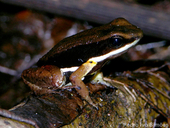|
Allobates myersi (Pyburn, 1981)
Myers' Poison Frog | family: Aromobatidae genus: Allobates |
 © 2013 Pedro Ivo Simoes (1 of 1) |
|
|
|
Description Allobates myersi has general similarities with A. femoralis, A. zaparo, and others of the femoralis species group. It can be differentiated from A. femoralis because A. myersi either lacks or has an indistinct dorsolateral strip while A. femoralis has a distinct stripe. Allobates myersi coloration (see below) and skin texture differs from the red A. zaparo that has densely granulated skin. Lastly, A. myersi is larger than other frogs in the femoralis species group (Pyburn 1981).
In life, the dorsum of Allobates myersi is light to medium brown with dark brown granules that are relatively spaced. The gular and chest are blue-grey to dark brown, with the color breaking up into spots and/or reticulations on a creamy white abdomen. The sides of the head and body are blue-black, extending to the anterior base of the thigh and around the posterior end of the body to the vent. A pale cream ventrolateral stripe, starting below the nostril, runs along the upper lip and side of the body to the groin, where it becomes bright yellow. The axilla, posterior upper arm surface, and anterior thigh surface are also bright yellow. The lower surface of the hindlimbs is patterned like the abdomen, but there is an irregular black band or black spots on the posterior thigh surface that extends from the knee to the vent. Above the band/spots, the thigh is reddish-brown to coral red. The rest of the hindlimb is colored like the dorsum. There is no sexual dimorphism in coloration or patterning. The iris is gold suffused with black. In preservative, A. myersi has a light to medium brown dorsum and a white ventrolateral stripe (Pyburn 1981).
Distribution and Habitat Country distribution from AmphibiaWeb's database: Colombia, Peru
Life History, Abundance, Activity, and Special Behaviors The form of amplexus in this species is unknown, but family trends suggest that they have cephalic amplexus. Allobates myersi is oviparous, and eggs are deposited on leaf litter. Clutch size and egg characteristics are unknown. Parental care is likely provided by males, who guard the eggs until they hatch and then carry the tadpoles to a stream. Embryos hatch as free-living larvae. They have an unknown development time and preferred habitat. It is unknown what adults or larvae eat, and it is unspecified what particular predators eat them. Adult frogs have aposematic flash coloration (Acosta-Galvis and Rueda 2004).
The Dendrobatid family, of which Allobates myersi is a member, is well known for having toxic skin secretions (Pyburn 1981).
Trends and Threats Possible reasons for amphibian decline Habitat modification from deforestation, or logging related activities Comments Allobates myersi is thought to be closely related to Allobates femoralis, but no molecular studies have been done yet (Pyburn 1981).
Allobates myersi is named after Charles W. Myers of the American Museum of Natural History for his work in dendrobatids (Pyburn, 1981).
References
Acosta-Galvis, A., Rueda, J.V. 2004. Allobates myersi. In: IUCN 2012. IUCN Red List of Threatened Species. Version 2012.2. Pyburn, W.F. 1981. A new poison-dart frog (Anura: Dendrobatidae) from the forest of southeastern Colombia. Proceedings of the Biological Society of Washington: 67-75.
Species Account Citation: AmphibiaWeb 2013 Allobates myersi: Myers' Poison Frog <https://amphibiaweb.org/species/1667> University of California, Berkeley, CA, USA. Accessed Jan 1, 2025.
Citation: AmphibiaWeb. 2025. <https://amphibiaweb.org> University of California, Berkeley, CA, USA. Accessed 1 Jan 2025.
AmphibiaWeb's policy on data use.
|


 Map of Life
Map of Life